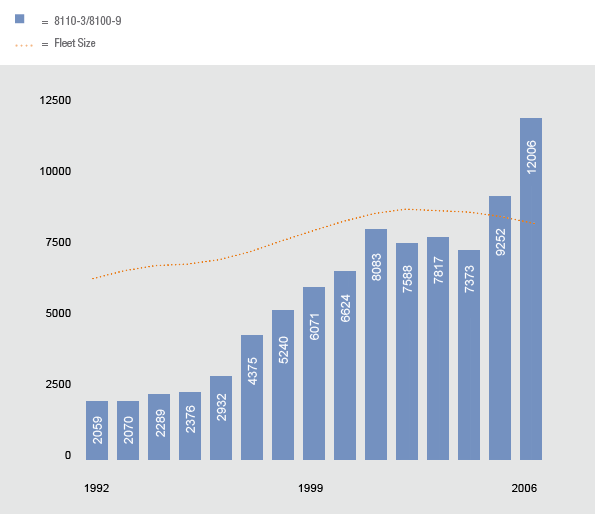
REQUESTS VERSUS FLEET SIZE
(707, 727, 737, 747, 757, 767, 777)
Figure 2

Although this means Boeing will continue to provide an 8100-9 approval for major repairs, an EU operator and MRO in those six EU member states can now use Boeing acceptable data for minor repairs without additional EASA or EASA DOA approval.
A new bilateral agreement between the U.S. and the EU is planned to be signed in the near future, allowing implementation of the mutual acceptance of repair data by all EU member states.
GROWING DEMAND FOR APPROVED DATA
During the last 15 years, Boeing has seen a significant increase in demand for approved structural repair data requests from operators, while the number of Boeing airplanes in the fleet has not grown proportionately (see fig. 2). This increase primarily involves Boeing 707, 727, 737, 747, 757, 767, and 777 airplanes. The demand for approved structural repair data for the Douglas fleets — DC-8, DC-9, MD-80/90, DC-10, MD-11, etc. — has remained relatively steady during the last several years.
The aging of the airplane fleet alone does not appear to explain this significant increase in operator requests. The data suggests that operators may not fully understand the regulatory requirements that dictate approved versus acceptable data, or are asking for approved data for nonregulatory purposes, such as for records to support future airplane ownership transfer. There is also a higher demand for approved data from EU member states than the rest of the world.
The increased demand challenges Boeing Delegated Compliance Organization resources, resulting in extended — and often unnecessary — airplane downtime.
HOW OPERATORS CAN GET THE DATA THEY NEED FROM BOEING
Boeing encourages all operators and MROs to use the Boeing SRM whenever possible, because all repairs in the SRM have been approved by the FAA. Additionally, operators and MROs should familiarize themselves with FAA AC 120-77, which provides guidance for minor deviations from allowable damage limits in the SRM and other manufacturer’s service documents resulting in greater applicability to more repairs.
Finally, when submitting a request to Boeing for either acceptable or approved repair data, follow the process contained in the appropriate multi-model service letter “Boeing Approval of Airplane Structural Repairs” (e.g., 737-SL-51-027-F). Using this process helps ensure that all the information needed to evaluate the repair design is available and can be efficiently processed.
SUMMARY
Boeing strives to provide accurate and responsive fleet support to operator requests for repair data. By understanding applicable regulations, using the Boeing SRM, and following established procedures, operators can receive the information they need efficiently, reducing airplane downtime. The value of structural repairs contained in the Boeing SRM is that they are available for immediate use by the operator and are approved by both the FAA and EASA.
For more information, please contact your local Boeing Field Service representative or Dale Johnson at dale.r.johnson2@boeing.com or Ron Lockhart at ronald.j.lockhart2@boeing.com.

